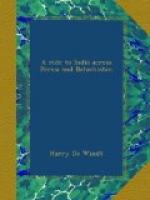The palace of “Chil Situn,” or “The Forty Pillars,” is like most Persian palaces—the same walled gardens with straight walks, the usual avenues of cypress trees, and the inevitable tank of stone or marble in the centre of the grounds. It is owing to the reflection of the facade of the palace in one of the latter that it has gained its name. There are in reality but twenty pillars, the forty being (with a stretch of imagination) made up by reflection in the dull and somewhat dirty pool of water at their feet. The palace itself is a tawdry, gimcrack-looking edifice, all looking-glass and vermilion and green paint in the worst possible taste. From the entrance-hall an arched doorway leads into the principal apartment, a lofty chamber about ninety feet long by fifty broad, its walls covered with large paintings representing the acts of the various Persian kings. Shah Abbas is portrayed under several conditions. In one scene he is surrounded by a band of drunken companions and dancing-girls, in costumes and positions that would hardly pass muster before our Lord Chamberlain. This room once contained the most beautiful and costly carpet in all Persia, but it has lately been sold “for the good of the State,” and a dirty green drugget laid down in its place. In one of the side chambers are pictures representing ladies and gentlemen in the costume of Queen Elizabeth’s time. How they got to Ispahan I was unable to discover. They are very old, and evidently by good masters.
The way back to our comfortable quarters at Djulfa lay over the Zandarood river. There are five bridges, the principal one being that of Allaverdi Khan, named after one of the generals of Shah Abbas, who superintended its construction. It is of solid stonework, and built in thirty-three arches, over which are ninety-nine smaller arches above the roadway on both sides, enclosing a covered-in pathway for foot-passengers. The roadway in the centre, thirty feet wide, is well paved with stone, and perfectly level. Every thirty yards or so are stalls for the sale of kababs, fruit, sweetmeats, and the kalyan, for a whiff from which passers-by pay a small sum. Ispahan is noted for its fruit; apricots, peaches, nectarines, cherries, mulberries, and particularly fine melons, are abundant in their season.
There is a saying in Persia, “Shiraz for wine, Yezd for women, but Ispahan for melons.”
Since it has ceased to be the capital of Persia, the trade of Ispahan has sadly deteriorated. There is still, however, a brisk trade in opium and tobacco. Silks and satins are also made, as well as quantities of a coarser kind of cotton stuff for wearing-apparel, much used by the natives. The sword-blades manufactured here are, in comparison with those of Khorassan or Damascus, of little value. Genuine old blades from the latter city fetch enormous prices everywhere; but a large quantity of worthless imitations is in the market, and unless a stranger is thoroughly experienced in the art of weapon-buying, he had better leave it alone in Persia. Modern firearms are rarely seen in the bazaars, except cheap German and French muzzle-loaders, more dangerous to the shooter than to the object aimed at.




